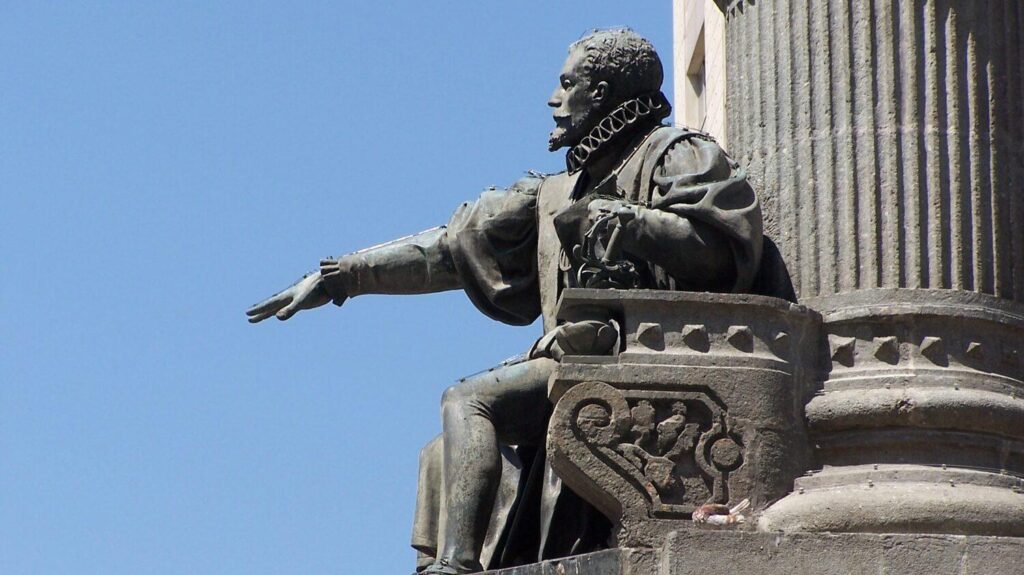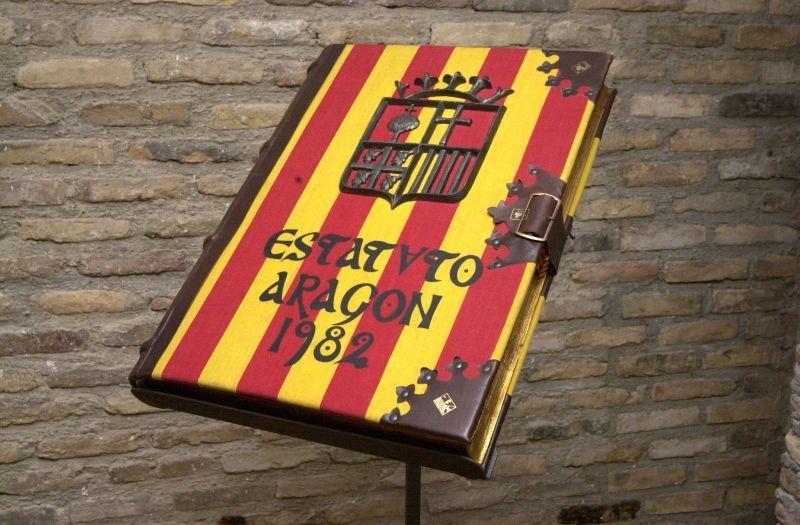Esta entrada también está disponible en: Aragonés Català Español Français English
QUARTER AND A HALF OF A HEAD
Maybe Juan de Lanuza was a bit stupid when he returned to Saragossa knowing that Philip II’s police were looking for him, but I think you would have done the same.
Let’s see, think about it. You’re in Épila, which must be a place with wonderful people and, if it’s your town, you’ll have a great time at the fiestas, but let’s be honest: if you’ve just arrived, there’s nothing to do there. Dry land as far as the eye can see.
That’s what must have happened to Lanuza, he was dying of boredom so much that he said, boy, I’ll take my chances, this is unbearable. The Palace of the Count of Aranda, after a month, I already know it by heart. I can’t take any more. He took the bus from Agreda and went to Saragossa. Now it would have been another story because there is a swimming pool, gymnasium and even Radio Épila, but in the 16th century I don’t think the sports centre had been built yet.
However, at the time, when he was going to face the Castilian troops, Épila was a luxury for him. Imagine: the army that he led and the one that came from Castile (pissed off because they didn’t let them take Antonio Pérez with them) met in Utebo to fight each other. And when Juan arrives, it’s like the centre of Jaca on 15 August.
Like when you invite a friend to a birthday party and he brings all his cousins. It looked like the Castilians had announced it on Instagram. Juan ordered the withdrawal and left for Épila because, I imagine, sharing the pizzas they had ordered with so many people seemed impossible.
So, after the battle was over and after a month, Juan took the Ágreda and went to Saragossa. The cops of the time stopped him and took him to what is nowadays the Cyclone Passageway (Pasaje del Ciclón), the one next to Pilar Square (Plaza del Pilar), which has ice creams, milkshakes, biscuits and you can have some tapas or whatever you want. For a moment, Juan thinks about the flavour of milkshake he’s going to order, but then he realises that the passage in the 16th century is more like a palace with a dungeon and the poor guy is left there until the exaggerated guys, who hadn’t got over Antonio’s little issue, cut off his head.
I’m also telling you that it’s okay to be angry, but maybe exposing his head in the Market Square for two whole years is a bit too much of a spiteful thing to do.
Juan lost his head (literally) for defending the Aragonese privileges, would you have done the same? By the way, do you know if we still have the fueros in Aragon now? Take a look below to find out.
Description
On 20 December 1591, the Justice of Aragon (El Justicia), Juan de Lanuza, was executed in Market Square (Plaza del Mercado) in Saragossa. This event was a consequence of the repression ordered by King Philip following the rebellion in which the Justice had confronted the monarch, accusing him of attacking the Aragonese charters.

This historical event must be understood in a very complex context. After the disappearance of the Justiciazgo (Justice institution) at the beginning of the 18th century, the figure of Lanuza and the institution he represented remained as symbols of Aragonese identity. In the 1980s, with the entry into force of the Statute of Autonomy, the Justice of Aragon was recovered as an institution adapted to the framework of democratic freedoms. The Justice watches over the rights of citizens and monitors compliance with the Statute and the Aragonese legal system.
The date of 20 December has a component of remembrance of the past, but it also helps us to understand the value of our current rights and to recognise the many things that can be improved.
For further information
On the website of The Justice of Aragon/El Justicia de Aragón (chronicle of the acts carried out in the commemoration of 2022).

The objectives and contents of this proposal can be related to the one linked to 23 April: Aragon Day. Also with the 6th of January (Day dedicated to Aragonese law).
A reflection…
In 2022, the Statute of Autonomy of Aragon will be forty years old. During that time, the original text has been modified and updated, but neither its spirit nor its main purpose has changed: to provide Aragonese citizens with rules of coexistence and guidelines for the progress of an increasingly plural and multicultural society in an increasingly globalised world.

Among many other things, such as the development of Aragonese civil law, the protection of linguistic modalities and the definition of representative institutions, control and government of the community, the Statute regulates the institution of the Justice of Aragon.
… and a detail
The Justice of Aragon is the third institution, after the Government of Aragon and the Cortes, in the current system of our autonomous community. It is highly valued, as it makes visible day-to-day problems of concern to the vast majority of Aragonese (for example, by processing complaints that anyone can file), that it exercises its powers in the area of justice, and that it is the only institution in the Autonomous Community of Aragon that is able to deal with the problems that concern the vast majority of Aragonese people.
Many of its actions also involve the collaboration of other social agents, local entities, groups and non-governmental organisations, etc.
Their annual reports, whether general or on specific issues (which sometimes take the form of appearances in the Aragonese Parliament), give a very approximate idea of the social reality of our community.

Suggestions for teachers
Some of the proposals served here could be compatible within the educational campaign (didactic talks in secondary schools) that the Government of Aragon has undertaken in 2022 around the Statute of Autonomy on the occasion of its 40th Anniversary.
For example, the evolution of Aragon in these four decades can be analysed from the data provided in a statistical statistical notebook with very simple and revealing comparative indicators .
Details and tasks of the institution of The Justice of Aragón (El Justicia de Aragón) can be explored through its own website. From there, the functions assigned to this institution can be discussed in the classroom. A possible visit to its headquarters in Saragossa, in the palace of Armijo, can also be considered.
In a more contextualised way (origin and evolution of the institution of The Justice (El Justicia), related legends, historical significance, etc.), it is very useful to consult the exhibition “El Justicia de Aragón, 1265-2015”, designed by Rolde de Estudios Aragoneses for the Town Council of Ejea de los Caballeros on the occasion of the 750th anniversary of the institution:
Also the article The Justice, much more than a myth.
Objectives that this proposal helps to achieve
ESO:
- To assume responsibly their duties, to know and exercise their rights in respect for others, to practice tolerance, cooperation and solidarity among individuals and groups, to exercise in dialogue, strengthening human rights and equal treatment and opportunities between women and men, as common values of a plural society, and to prepare for the exercise of democratic citizenship.
- To know, value and respect the basic aspects of one’s own and others’ culture and history, as well as artistic and cultural heritage.
Baccalaureate:
- To exercise democratic citizenship, from a global perspective, and acquire a responsible civic conscience, inspired by the values of the Spanish Constitution, as well as by human rights, which fosters co-responsibility in the construction of a just and equitable society.
- To consolidate personal and social maturity that allows them to act responsibly and autonomously and to develop their critical spirit. To foresee and resolve personal, family and social conflicts peacefully.
Subjects with which it can be linked
- Geography and History / Ethical values (ESO, 1st and 2nd cycles)
- Education for citizenship and human rights (ESO, 2nd cycle)
- Baccalaureate: To be assigned according to modality / History and Culture of Aragon
Development of competences
- Social and civic competences
- Cultural awareness and expressions
